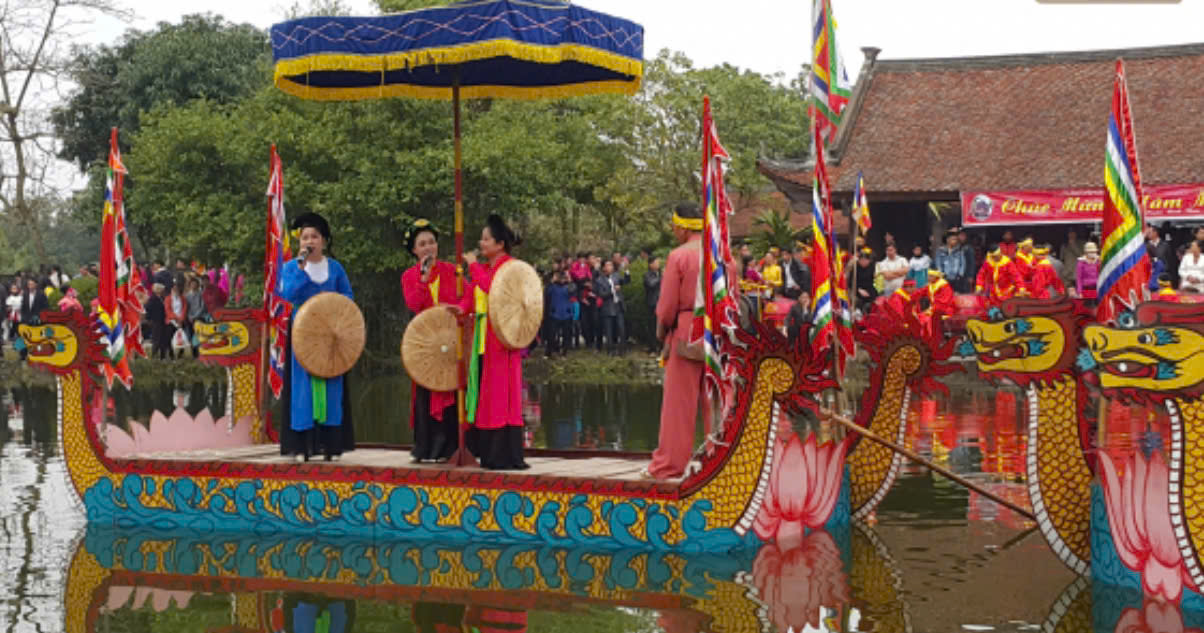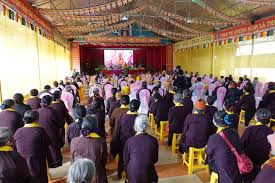Keo Pagoda Festival in September
The Keo Pagoda Festival is celebrated with religious rituals and traditional customs to honor Zen master Dương Không Lộ, who made significant contributions to the people and the country. Through folk art performances, the lifestyle of the Red River Delta residents, deeply imbued with the agricultural culture of the Northern Plains, is also recreated. With its spiritual and historical values, the Keo Pagoda Festival in Thai Binh is truly a place that embodies cultural values worthy of being recognized as a National Intangible Cultural Heritage.
Keo Pagoda Festival Recognized as National Intangible Cultural Heritage in 2017
1. The History of the Festival's Formation
According to the usual customs of our ancestors, when someone passes away, the family holds a death anniversary on the day of their passing; when a deity or saint dies, the festival is held on the day of their death for remembrance. However, the Keo Pagoda Festival does not follow this common practice. Saint Dương Không Lộ was born on September 14, 1016, and passed away on June 3, 1094, but the main festival at Keo Pagoda is held over three days, from the 13th to the 15th of September in the lunar calendar. In the past, to choose an appropriate time for the festival, the elders of the village harmoniously combined two grand ceremonies and one period (month) into one large procession. The 13th is the grand "bách nhật" ceremony (100-day offering since his death, on the third day of June); the 14th marks his birthday; and the 15th is the full moon ceremony of Buddhism. Additionally, the village of Keo intentionally chose the 14th, Saint Dương Không Lộ’s birthday, as the day to organize the festival, which is quite unique. On that day, the saint joyfully enjoys the offerings and delights in the festivities. When the French arrived at Keo Pagoda, they observed that the ancestors in the village had a progressive worldview, valuing the day of birth more than the day of death (treating the "bách nhật" anniversary like a death anniversary).
Ancient Photo of the Holy Palanquin Procession in the Traditional Keo Pagoda Festival
2. The Autumn Festival at Keo Pagoda in Thai Binh Features Unique Rituals
The rituals at the Keo Pagoda Festival in Thai Binh, the life of Zen master Dương Không Lộ is reenacted as a historical performance through two main ceremonial parts: the Holy Palanquin Procession and the Frog-catching Dance.
a. The Holy Palanquin Procession
The Holy Palanquin Procession is carried out over the three main festival days, from the 13th to the 15th of September in the lunar calendar. The procession begins from the "Upper Sanctuary" and moves to the "Outer Gate." In the evening, the Holy Tablet is brought back into the "Incense Altar." The procession out and back follows a closed "Á" shape, called "xuất á, nhập á."
The procession includes: the "phúc" team, consisting of elderly monks dressed in brown robes, holding a fan in one hand and a long strip of cloth in the other, called to carry the saint; the cowherd team, holding spirit flags, representing the children who herded cows and gathered grass, being close to Không Lộ when he practiced fishing; two horses, one red and one white; a cart carrying drums and gongs; a group of elderly men holding ceremonial bowls; a musical ensemble; a team performing the "sênh tiền" dance; a small altar on a cart; the procession bearers carrying the dragon throne; the team carrying the incense altar; and the people and visitors. The procession is managed by the festival leader and the flag captain.
The Holy Palanquin Procession
The procession starts from the sanctuary and moves out of the outer gate, covering a distance of about 500 meters. In the morning, when the saint is taken out, the procession goes along the eastern side of the pond, and in the afternoon, the saint is returned via the western side. While the procession is happening along the shore, a boat race takes place in the pond in front of the pagoda. Eight children, aged around 13-14, wear yellow clothes and red head scarves tied in the shape of two peaches. They sit in four balanced pairs, rowing with wooden paddles on a small boat called a "cò cốc boat." On the boat, there are also two adults, one hitting the drum and the other steering the boat. Both wear yellow clothes, yellow headscarves, and red sashes tied on the left. The paddles strike the water in rhythm with the drum and the chants of "hò dô," making the cò cốc boat glide smoothly across the surface of the pond. The boat race is a performance for the worship of the saint.
b. Frog-catching Dance
On the afternoon of the 14th, while the boat race continues, a ceremonial dance for the saint takes place in the pagoda at the altar. It is an ancient dance known as the "frog-catching dance" to the villagers of Keo.
Twelve people, the main bearers of the palanquin, dressed as they were during the procession, stand in two rows in the middle area, facing the main hall. The drum leader taps the small drum to give instructions. After the introductory drumbeat, the two rows of bearers stand in order. The drum leader taps the drum again, and the bearers place both hands in front of their chests, kneel down, with their palms resting on the ground in front of them. The soles of their feet point outward, and their heels come together, lifting their hips. The drum sounds again, and the bearers swing their arms to the left, rising back to their original position. This sequence is repeated five times. These simple movements look strong and decisive. This is a stylized form of the saint's ritual, performed by the twelve bearers of the palanquin as a dance.
3. The Keo Pagoda Festival Reflects the Culture of Agricultural Communities
At the Keo Pagoda Festival in Thai Binh, visitors not only experience spiritual needs through traditional rituals but also enjoy cultural activities that reflect the spirit of the northern agricultural community.
At the festival, many folk games attract the interest of visitors, including human chess, pottery breaking, and tug-of-war. Especially, the “boat cruise singing” performance is highly awaited by tourists, featuring traditional folk songs and exchanges.
In the traditional festival of Keo Pagoda, the boat racing competition is the typical event that represents the cultural traits of the agricultural people during the festival season. Participants in the race are young men wearing loincloths, short-sleeved tunics, and matching headbands. When the announcer conveys the orders of the event’s leader and reminds everyone of the race rules, the racers get ready. After a tense waiting moment, the sound of a large drum is heard from the riverbank, and the boats begin to row. The drumbeat follows, with paddles moving evenly on both sides, and the helmsman stomps their feet. The actions of the participants are in sync with the drumbeat and the chants of "Dô hò," as the boats glide swiftly across the river. In the minds of the people in the area, the boat race festival not only creates an exciting and joyful atmosphere, wiping away everyday worries, allowing people to truly experience a sense of intoxication with the sky, clouds, and water, but the Keo Pagoda boat race is also a prayer from the locals to the divine world, stirring the dragon's palace and waking the Water God to listen to the people's prayers. This, in turn, ensures the regulation of the annual water levels, allowing people to farm easily with favorable rain, wind, and bountiful harvests. The water source is considered a blessing, bringing fortune for the entire year.
Old photo capturing the race competition
Conclusion
Keo Pagoda is a particularly valuable cultural heritage. Visitors not only get to admire the scenery but will also find moments of relaxation while strolling beneath the ancient trees such as the cotton tree, banyan tree, and big-leaf tree, whose branches sway and provide cool shade. The magnolia, jackfruit, and soapberry trees, along with the surrounding banyan and longan trees, stand quietly by the shimmering lake, creating a pastoral scene filled with the hues of the homeland, leaving even the most indifferent person touched. Especially, visiting Keo Pagoda in Thai Binh during the festival season will offer a unique opportunity to truly experience a space that deeply reflects the national cultural identity.
Information and Communication Department, Keo Pagoda – Thai Binh
!["[KTMH] Trailer | WHAT TO DO TO MAKE SUMMER HOLIDAYS MORE MEANINGFUL?"](https://i3.ytimg.com/vi/s0VUGa1v6uw/maxresdefault.jpg)

.jpeg)

.jpg)